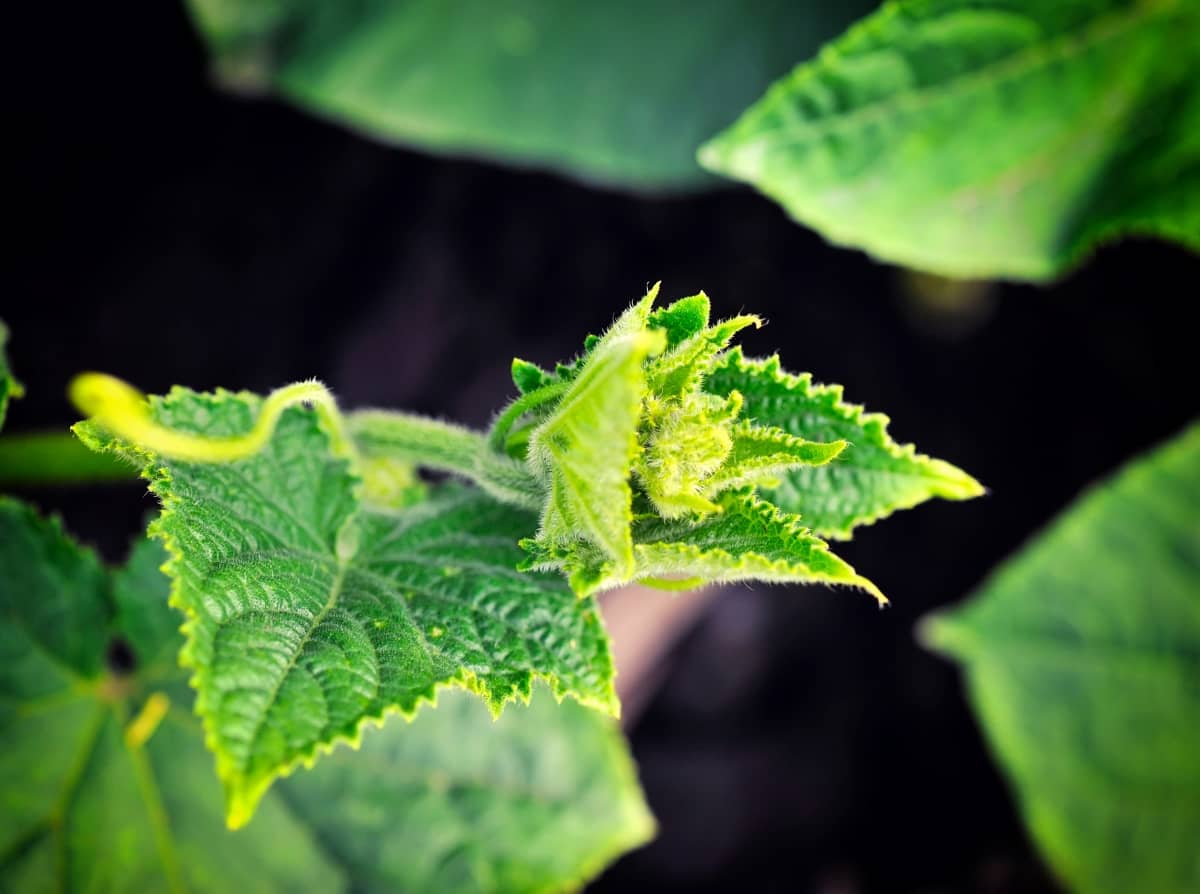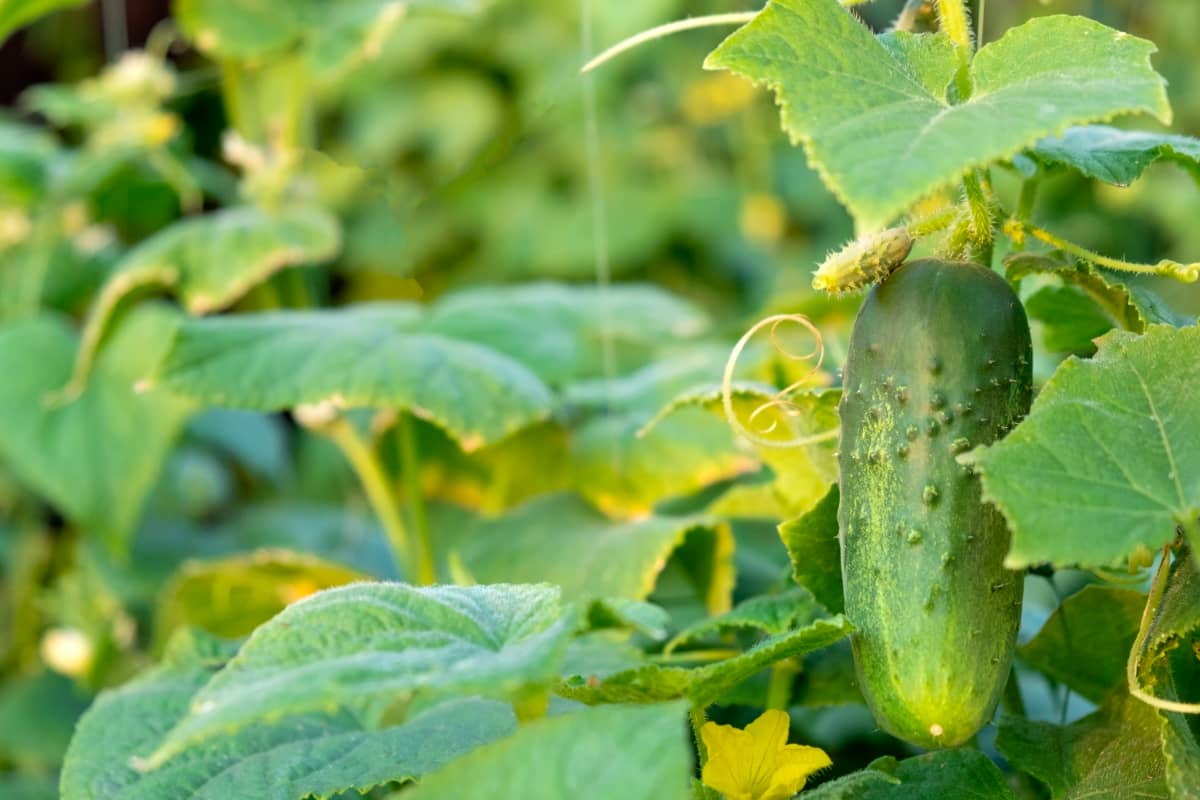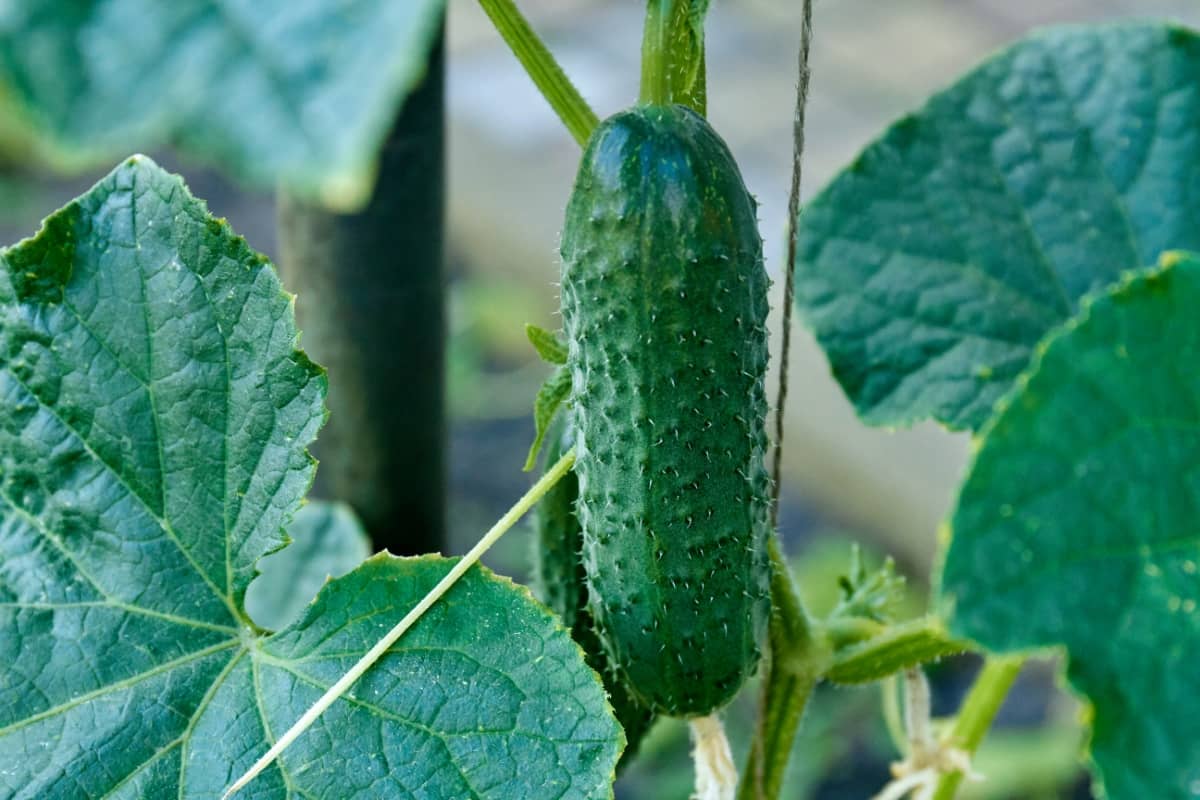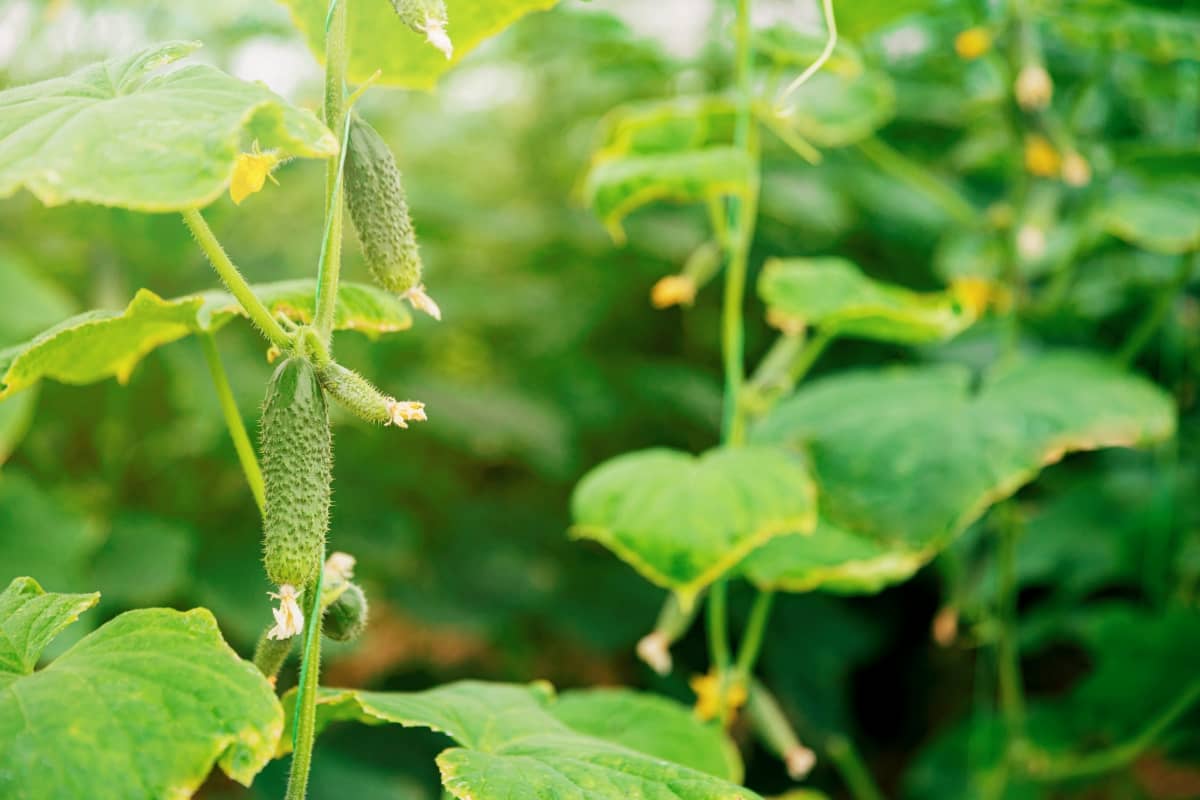Cucumbers belong to the family member of the gourd or Cucurbitaceae. Yellow leaves in Cucumber plants can significantly impact their overall yield. When the leaves turn yellow, it indicates something wrong with the plant’s health and development. This can result in reduced productivity and lower-quality Cucumbers.

Nutrient Deficiencies May Be the Reason for Yellow Leaves of Cucumber
Nutrient deficiencies can often be the culprit behind yellowing Cucumber leaves. These plants rely on a balanced supply of essential nutrients to thrive and produce healthy foliage. Their Cucumber leaves can turn yellow when lacking key elements such as nitrogen, magnesium, or iron. Nitrogen deficiency is one common cause of yellowing leaves in Cucumbers. This nutrient plays a crucial role in leaf growth and chlorophyll production. Without enough nitrogen, the plant’s leaves may lose their vibrant green color and develop a pale or yellowish hue.
Another nutrient deficiency that can lead to yellowing leaves is magnesium deficiency. Magnesium is involved in numerous metabolic processes within the plant and helps promote chlorophyll synthesis. A lack of magnesium can result in interveinal chlorosis –the veins remain green while the areas between them turn yellow. Iron deficiency is also known to cause yellowing of Cucumber leaves.
When iron levels are insufficient, it affects the plant’s ability to produce energy efficiently, leading to leaf discoloration. To prevent these nutrient deficiencies in Cucumbers from occurring, it’s important to ensure that your Cucumber plants receive proper fertilization with a balanced blend of macronutrients (nitrogen, phosphorus, potassium) and micronutrients (magnesium, iron). Regular soil testing can help identify any imbalances or deficiencies so that appropriate amendments can be made.
Pest Infestations Causing the Yellowing of Cucumber Leaves
One of the possible causes of yellow leaves on Cucumber plants is pest infestations. A common cause is the aphid. These pesky insects are known for sucking sap from plant leaves, causing them to turn yellow and wilt. Spider mites are another menace that can discolored and damage your Cucumber leaves. They feed on plant tissues, leaving behind pale or yellow spots as they go.
Cucumber beetles are yet another pest that can cause leaf discoloration. Regularly inspect your Cucumber plants for any signs of trouble to prevent or address a pest infestation. Integrating pest management techniques such as removing affected foliage and introducing beneficial predators like ladybugs can help control these unwelcome guests.
Impact of Temperature, Light, and Humidity on Cucumber Leaf
The temperature, light, and humidity levels play a crucial role in maintaining the health and vigor of Cucumber leaves. Extreme temperatures can cause stress to the plants, leading to yellowing of the leaves. High temperatures above 32°C can inhibit photosynthesis and result in leaf discoloration. Similarly, insufficient light or excessive shade can also affect the coloration of Cucumber leaves. Cucumber plants require at least six hours of direct sunlight daily for optimal growth.
In case you missed it: Cucumber Plant Looks Healthy but No Flowers: Reasons, Tips, How to Fix, and Remedies

To maintain ideal conditions for your Cucumber plants, ensure adequate sunlight exposure while protecting them from extreme heat or cold. Additionally, provide proper ventilation and avoid overcrowding plants to reduce moisture buildup. Remember, keeping a close eye on temperature fluctuations, light availability, and humidity levels will help prevent yellowing or other leaf-related issues in your precious Cucumbers.
Overwatering and Poor Drainage May result in Yellow Cucumber Leaves
When you give your Cucumber plants too much water or if the soil doesn’t drain properly, it can cause the plant roots to become waterlogged. As a result, essential nutrients like nitrogen may not be efficiently absorbed by the roots, leading to yellowing leaves. Stagnant water around the root system prevents proper airflow and encourages anaerobic bacteria growth.
These harmful bacteria attack healthy tissue and cause damage, resulting in yellow spots on Cucumber leaves. To prevent overwatering and poor drainage issues, ensure adequate spacing between plants for proper air circulation. Consider using raised beds or containers with well-draining soil mixtures specifically formulated for vegetables like Cucumbers. Regularly monitor soil moisture levels before watering again.
Fungal Infections May Cause Yellow Spots on Cucumber Leaves
One common cause of yellow spots on Cucumber leaves is fungal infections. When fungal spores land on the leaves, they can penetrate the plant’s tissues and feed on nutrients. As a result, yellow spots may appear on the affected leaves. The most common fungal infection affecting Cucumber plants is powdery mildew. This disease manifests as white or grayish patches that eventually turn yellow and cause leaf wilting.
Another fungal infection known as downy mildew can also lead to yellow spots. Unlike powdery mildew, downy mildew causes angular-shaped lesions with yellow coloration. To prevent and treat fungal infections, it’s essential to maintain proper air circulation around the plants by spacing them adequately. In addition to cultural practices, applying fungicides specifically formulated for Cucumber diseases can effectively control these infections.
Viral Diseases Effects on Cucumber Leaf Coloration
One common viral disease in Cucumbers is Cucumber Mosaic Virus (CMV). This virus causes light and dark green mosaic patterns on the leaves, along with yellow spots and streaks. Another viral disease is Cucumber Green Mottle Mosaic Virus (CGMMV), which causes yellow mottling or discoloration on the leaves. These viral infections can weaken the plants and affect their growth and productivity. Infected plants may produce smaller and misshapen fruits, reducing yield significantly.
In case you missed it: Cucumber Companion Plants: What to Grow and What Not to Grow with Cucumber Plants

Preventing viral diseases in Cucumbers can be challenging, as there are no effective treatments once a plant is infected. However, you can reduce the risk by practicing good hygiene, such as removing weeds that could harbor viruses or using virus-free seedlings. Crop rotation also helps prevent the spread of viral diseases from one season to another. Additionally, controlling insect vectors like aphids can minimize the transmission of these viruses between plants.
Bacterial Infections Result in Yellowing of Cucumber Leaves
One common bacterial infection that affects Cucumber plants is bacterial wilt. This is caused by the bacterium Erwinia tracheiphila and is transmitted by striped or spotted Cucumber beetles. Infected plants often exhibit wilting, yellowing, and eventual death. Another troublesome bacterial infection is the angular leaf spot, caused by the Pseudomonas syringae pv. lachrymans. This pathogen can lead to yellow spots on Cucumber leaves and lesions that resemble water-soaked areas.
Bacterial leaf spot is mainly caused by Xanthomonas campestris pv. cucurbitae is yet another culprit behind yellowing foliage in Cucumbers. This bacterium attacks various parts of the plant and results in necrotic patches on leaves, which turn yellow over time. To prevent these bacterial infections from taking hold in your garden, practice good sanitation measures such as removing infected plant debris promptly and rotating crops regularly. Additionally, consider using disease-resistant varieties when planting Cucumbers.
Physiological Disorders Contribute to Yellow Spots on Cucumber Leaves
One common physiological disorder is edema, which occurs when there is an imbalance between water absorption and transpiration in the plant. This can lead to small blisters or corky spots on the Cucumber plant leaves, causing them to turn yellow. Another disorder that can result in yellow spots is sunburn. Cucumber plants need a certain amount of sunlight to thrive, but excessive exposure can cause damage to their delicate leaves. When this happens, you may notice patches of yellowing or browning on the affected areas.
In addition, nutrient imbalances within the plant can contribute to physiological disorders and result in yellow spots on Cucumber leaves. For example, a deficiency in magnesium or iron can lead to chlorosis, a condition where the plant leaves lose their green color and turn yellow. It’s important to address these physiological issues promptly by adjusting watering schedules, providing shade during peak sunlight hours, and ensuring proper nutrient levels in your soil. You’ll help maintain healthy Cucumber plants with vibrant green foliage.
Impact of Chemicals on Cucumber Leaf Health and Color
Chemicals, such as pesticides and fertilizers, play a crucial role in agriculture by protecting crops from pests and providing essential nutrients. However, excessive or improper use of these chemicals can harm plant health and color. Fertilizers are necessary for providing plants with essential nutrients for growth.
In case you missed it: 10 Organic Solutions for Cucumber Pests and Diseases

However, overuse or improper application can result in nutrient imbalances that affect leaf coloration. Excessive nitrogen levels can cause leaves to become yellowish-green or pale. Growers need to follow instructions when using chemicals on their Cucumber plants carefully. Using organic alternatives whenever possible and applying them at recommended rates will help minimize negative impacts on leaf health and color.
Conclusion
Yellowing leaves on Cucumber plants can be caused by various factors, ranging from nutrient deficiencies to pest infestations and even adverse environmental conditions. Yellow spots on Cucumber leaves can be a cause for concern among gardeners. With its annual climbing or spreading nature, the Cucumber plant is a common sight in gardens and farms.
- Feed Your Flock for Less: Top 10 Tips to Save on Chicken Feed
- Ultimate Guide to Ossabaw Island Hog: Breeding, Raising, Diet, and Care
- Hatching Answers: The Top 10 Reasons Your Chickens Aren’t Laying Eggs
- Eggs and Economics: Breaking Down the Cost of Raising Backyard Chickens
- Defend Your Greens: Proven Methods to Keep Iguanas Out of Your Garden
- Ultimate Guide to Cinnamon Queen Chicken: A Comprehensive Guide for Beginners
- Ultimate Guide to California Tan Chicken: Breeding, Raising, Diet, Egg-Production and Care
- Ultimate Guide to Marsh Daisy Chicken: Breeding, Raising, Diet, and Care
- 10 Types of Chicken Farming Businesses You Can Start for Profits